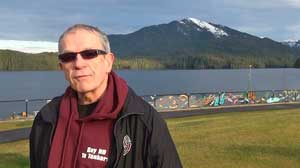
Gary Coons, the NDP member of the British Columbia Legislative Assembly for North Coast, has told the Northern Gateway Joint Review Panel that Enbridge is “attempting to silence voices from the North Coast” by asking to limit the time of non-aboriginal intervenors before the panel.
Earlier Monday, Enbridge filed a motion with the Joint Review Panel asking that it limit non-aboriginal intervenors appearing before the panel in Prince Rupert this weekend to just 10 minutes. As well as Coons, Enbridge singled out the Member of Parliament for Skeena Bulkley Valley, Nathan Cullen, also a candidate for the NDP leadership, the T. Buck Suzuki Foundation and the United Food and Commercial Workers union.
Enbridge says that the presentations will be a violation of a panel ruling that in this phase presentations must limited to personal knowledge.
Monday afternoon, Coons responded by filing a letter with the JRP that says:
I am disappointed and concerned that Enbridge is attempting to silence voices from the North Coast riding by limiting the time for oral evidence that is allocated to non-aboriginal participants to 10 minutes.
I can assure those concerned with my oral evidence that I have done my due diligence, I’ve studied the Procedural Direction for giving evidence (Procedural Direction #4), and will fall within the parameters of such. I believe I have a responsibility, and a right, as a resident of Prince Rupert for 35 years, to share my “personal knowledge, my experiences and the potential effects of the project on me and my community” and I will, as requested, “briefly share my point of view regarding the decision the Panel should make on the Project.”
More importantly, I have an obligation as MLA to submit oral evidence on behalf my constituents and of all communities that I have been entrusted to represent. As MLA, my “community” covers the North Coast riding. I have spent the last 6 months preparing for my presentation, knowing that there is criteria set out by the panel.
It does a great disservice to me and many others for Enbridge to attempt to change the rules at this point in the process and seek to limit the participation of those of us who are non-aboriginal to ten minutes. On July 30, 2011, I applied for and received from the panel 60 minutes to present oral evidence. Is Enbridge suggesting that the panel is not experienced enough to determine who may give oral evidence and how much time should be allocated to each participant? Surely these are decisions that should be made by the independent members of the panel, rather than lobbied for by those who stand to benefit by silencing the voices of those who would be most affected by this project.
The Joint Review Panel has done their due diligence by informing all interveners through written directions and in their opening remarks at each community hearing about the nature of their role as participants in the oral hearing and the directions they need to follow. The Panel is more than able to ensure that participants abide by these directions, and have been freely doing so throughout the process thus far. There are mechanisms in place which would allow Enbridge to object to testimony that they don’t believe meets the requirements of the Panel, and the Panel themselves should be responsible for ruling on objections as they arise.
Please take this response as a request to refuse the proposal put forward by Enbridge Northern Gateway Pipelines Limited.










